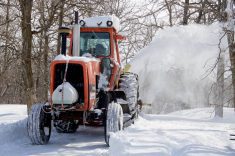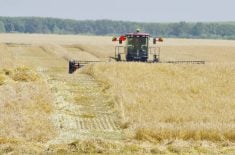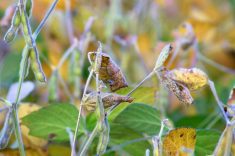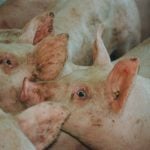Seeding progress across the province has been delayed with recent rains and currently sits at approximately 4 per cent of the acres being seeded. Producers have begun seeding spring wheat, barley, oats, and corn. The Central region is most advanced with approximately 12 per cent of each of the major cereals planted. Weeds are quickly appearing in fields including kochia, volunteer canola & wheat, flixweed, fleabane, foxtail barley, redroot pigweed, lamb’s quarters, thistles, and dandelions. Growers are encouraged to scout and use burn-off products to control weeds they see and as well use PRE-emergent products with residual control.
Cereals
Winter wheat and fall rye survival is decent, with most producers observing winter cereal survival to be 80 – 90 per cent. Most producers have completed fertilizer applications in their winter cereals.
Read Also

Seeding Indigenous agricultural prosperity
National Circle for Indigenous Agriculture and Food says Indigenous agricultural success needs strong relationships.
Spring wheat and barley are sitting at 9 per cent complete across the province with the Central region being the most advanced at 12 per cent complete. Earliest planted fields have started to emerge.
Oilseeds
No significant acres of oilseed crops planted to date.
Pulses and Soybeans
Field pea planting is at 11 per cent complete across the province. The Northwest region is the most advanced at 25 per cent complete and the Southwest region is at 7 per cent complete.
A few reports of soybeans being planted where soil conditions have been suitable.
Forages and Livestock
Forages
Recent rains have helped stimulate pasture growth and the landscape is beginning to green-up. Hay fields are in good shape, although icy conditions experienced this winter may have taken their toll on alfalfa plants in some locations.
Some producers have begun spreading fertilizer on their hay fields. Pastures and hayfields are starting to green up.
Alfalfa fields are starting to grow but cooler temperatures have slowed the growth rate. Hay quality from these fields may be compromised if significant amounts of alfalfa do not recover.
In the south-east, hog barns have found spreading manure to be a challenge due to moist field conditions.
Some annual cereals for silage/greenfeed are starting to go in.
Livestock
Most cattle remain in their winter-feeding areas. However, a handful of operations have made an early move to pasture, while others have chosen to open small paddocks adjacent to corrals, allowing animals more space and to get them out of the mud.
Many producers have adequate feed to last their cattle until summer turnout but will have minimal to no carryover feed.
Dugouts have been recharged from the recent snowmelt and spring run-off. Water levels are adequate for the time being.
Regional Comments
Southwest
The southwest region had rainy weather conditions during the week. Most areas received 20-30 mm of rain. Killarney and Wawanesa areas received 30-35 mm of rain. This past week saw daytime air temperature up to 20.5 C with overnight temperature down to -2.8 C.
Producers have started seeding in selected fields according to the seedbed conditions. Soil moisture is at optimum levels in most of the region. Eight per cent of spring wheat, 10 per cent of barley, and 7 per cent of peas are planted. Some early-seeded crops have germinated but no emergence being reported yet.
Winter wheat and fall rye crops responded to the recent rains well and growth is looking promising. Fertilizer applications are still ongoing.
Northwest
A good start to the week, with field operations beginning across most of the region. Cool, wet weather set in mid- week bringing precipitation to most of the region. Soil moisture is considered adequate. Most field operations were paused during the rain, although a few were able to resume shortly after. The weekend brought good drying weather as well as good progress to either start or resume operations.
Highest accumulations of rainfall were in Ethelbert at 35 mm and least precipitation was The Pas at 4 mm. Overnight temperatures dipped below 0 C with Alonsa station reporting -3.7 C. With the warm, dry weather over the weekend, most operations are underway now in terms of field preparation, spraying and seeding. There remains some standing water in fields which will require a couple more days of drying.
Field pea seeding is making good progress across most of the region at approximately 25 per cent complete, being more advanced towards Roblin area.
Spring wheat seeding is also nicely getting started and is approximately 10 per cent complete across the region.
Winter wheat and fall rye conditions vary across the region. There have been very few claims for winterkill damage.
Central
The past week was marked by prolonged periods of light rainfall across the Central region. All locations reported at least 14 mm. The extreme southeast of the region received the most rainfall with Windygates, Emerson, Gretna, and Altona all receiving more than 30 mm. These recent rainfalls and cooler temperatures have halted field operations for the time being, with some fields having standing water in low lying areas.
Although very little seeding progress was made over the past week due to the wet conditions, progress sits at approximately 12 per cent for oats, spring wheat, barley, and peas. A small number of producers have begun to seed canola, corn, and potatoes. The proportion of each crop seeded varies greatly at the local level across the region, with percentage of crops in the ground lower in the northwest and higher in the southeast.
Winter wheat and fall rye is growing quickly. Most producers have completed fertilizer applications in their winter cereals before the recent rainfall and are observing winter cereal survival to be 80 – 90 per cent.
Eastern
Rainfall accumulations across the Eastern region last week ranged from 5 to 35 mm with the greatest amounts in the central and southern parts of the region. Daytime temperatures cycled between below normal and normal ranges for this time of year. Nighttime lows started at or near freezing and then rose a few degrees for the remainder of the week. Winds were moderate to strong on most days making for good drying conditions.
Grain producers made limited progress on seeding and other field operations before rainfall shut things down completely. Activity resumed on Sunday and Monday in some northern districts which had the least amount of rainfall. There have been instances of equipment getting stuck in fields as growers push the limit of what is possible. Some low areas in fields, particularly in central and southern districts have standing water.
Winter cereal fertilizer applications are almost complete except for a few wet fields. Winter cereal survival is around 95 per cent with only a few fields being terminated. Warmer conditions and a closing window for timely fertilizer application dictated that stand evaluation decisions be made. Most fields display damaged areas that either took longer to green up or have plant mortality and thinner stands. Winter cereal field conditions range from fair to good.
No more than 5 per cent of spring wheat acres have been planted across the region along with about 2 per cent of corn acres. A few fields of canola and soybeans have also been seeded.
Interlake
There were scattered showers this past week across the Interlake region. Rainfall accumulation ranged from 20 mm to 25 mm. The southern part of the Interlake region received the most amount of rainfall. Very little field work has been done due to the wet soil conditions.
Fields are drying up from last week’s showers. Seeding progress across the south Interlake region is about 2 per cent complete with little to no seeding in the central to northern part of the Interlake. Producers are hoping to get started with seeding this week as weather allows. However, most fields need more drying time before seeding will get going.
Some fertilizer applications are ongoing on winter cereals. Winter cereals fields appear well established across the Interlake region with good survival rate. Fertilizer application progress in the Arborg area is about 3 per cent. There was some fertilizing of forage seed fields, hay stands and winter cereals before the rain last week and will resume rapidly once weather conditions become favourable. Some field operations including tillage, harrowing and herbicide application on established alfalfa fields was observed in the Ashern, Moosehorn and Steeprock areas.















